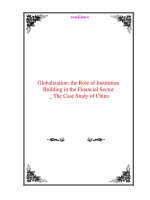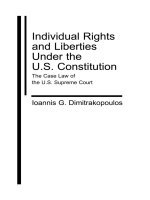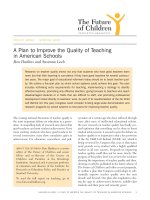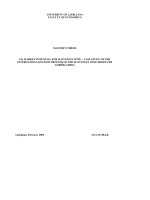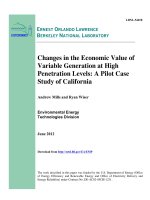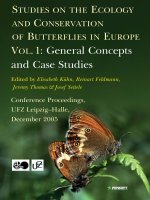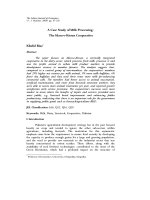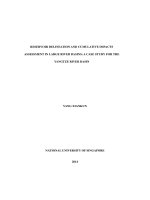- Trang chủ >>
- Cao đẳng - Đại học >>
- Luật
The WTO Case Law of 2003 The American Law Institute Reporters 039 Studies The American Law Institute Reporters Studies on WTO Law
Bạn đang xem bản rút gọn của tài liệu. Xem và tải ngay bản đầy đủ của tài liệu tại đây (2.2 MB, 327 trang )
This page intentionally left blank
THE WTO CASE LAW OF 2003
THE AMERICAN LAW INSTITUTE
REPORTERS’ STUDIES
This book is the third in a series of annual volumes that will be utilized
in the development of an American Law Institute (ALI) project on
World Trade Organization (WTO) Law. The volumes undertake a yearly
analysis of the case law from the adjudicating bodies of the WTO.
The Reporters’ Studies for 2003 cover a wide range of WTO law from
trade in goods to trade in services. Each case is jointly evaluated by
an economist and a lawyer, both well-known experts in the fields of
trade law and international economics. The Reporters critically review
the jurisprudence of WTO adjudicating bodies and evaluate whether
the ruling ‘‘makes sense’’ from an economic as well as legal point of
view, and if not, whether the problem lies in the interpretation of the
law or the law itself. The Studies do not always cover all issues discussed
in a case, but they seek to discuss both the procedural and the
substantive issues that form, in the Reporters’ view, the ‘‘core’’ of the
dispute.
H E N R I K H O R N is Professor of International Economics at the Institute
for International Economic Studies, Stockholm University. He is
a member of the Editorial Board of the World Trade Review and is
a member of the Centre of Economic Policy Research. He has previously
worked for the Economic Research and Analysis Division of the World
Trade Organization, and has been a judge in the Swedish Market Court
(supreme court for competition law).
is Edwin B. Parker Professor of Law at Columbia
Law School, Professor at the University of Neuchaˆtel, and a member of
the Centre for Economic Policy Research. He was previously Chair of
Competition Law, EUI, Florence, and a member of the Legal Affairs
Division of the World Trade Organization.
PETROS C. MAVROIDIS
THE WTO CASE LAW OF 2003
The American Law Institute
Reporters’ Studies
Edited by
HENRIK HORN
AND
PETROS C. MAVROIDIS
cambridge university press
Cambridge, New York, Melbourne, Madrid, Cape Town, Singapore, São Paulo
Cambridge University Press
The Edinburgh Building, Cambridge cb2 2ru, UK
Published in the United States of America by Cambridge University Press, New York
www.cambridge.org
Information on this title: www.cambridge.org/9780521834230
© The American Law Institute 2005
This publication is in copyright. Subject to statutory exception and to the provision of
relevant collective licensing agreements, no reproduction of any part may take place
without the written permission of Cambridge University Press.
First published in print format 2006
isbn-13
isbn-10
978-0-511-26636-2 eBook (EBL)
0-511-26636-7 eBook (EBL)
isbn-13
isbn-10
978-0-521-83423-0 hardback
0-521-83423-6 hardback
Cambridge University Press has no responsibility for the persistence or accuracy of urls
for external or third-party internet websites referred to in this publication, and does not
guarantee that any content on such websites is, or will remain, accurate or appropriate.
CONTENTS
Foreword
page vii
A Note on the American Law Institute
American Law Institute Reporters
viii
ix
1
Introduction
1
Henrik Horn and Petros C. Mavroidis
2
European Communities À Anti-Dumping Duties on
Imports of Cotton-Type Bed Linen from India
(AB-2000-13, WT/DS141/AB/R:DSR 2003: III, 965):
Recourse to Article 21.5 of the DSU by India
11
Gene M. Grossman and Alan O. Sykes
3
United States À Sunset Review of Anti-Dumping Duties on
Corrosion-Resistant Carbon Steel Flat Products From Japan
(AB-2003-5, WT/DS244/AB/R): A Legal and Economic
Analysis of the Appellate Body Ruling
31
Robert Howse and Robert. W. Staiger
4
United States À Continued Dumping and Subsidy
Offset Act of 2000 (WT/DS217/AB/R: DSR 2003:I,375)
Henrik Horn and Petros C. Mavroidis
52
5
European Community À Antidumping Duties on Malleable
Cast Iron Tube or Pipe Fittings from Brazil
(WT/DS219/AB/R: DSR 2003:VI, 2613)
87
Henrik Horn and Petros C. Mavroidis
6
United States À Final Determination with Respect to Certain
Softwood Lumber from Canada (AB-2003-6,
WT/DS257/AB/R)
130
Henrik Horn and Petros C. Mavroidis
v
vi
contents
7
United States À Definitive Safeguard Measures on Imports of
Certain Steel Products (WT/DS259; WT/DS252; WT/DS248;
WT/DS249; WT/DS251; WT/DS258; WT/DS254; WT/DS253:
DSR 2003:VII, 3117)
146
Gene M. Grossman and Alan O. Sykes
8
Mexico À Measures Affecting Telecommunications Services
(WT/DS204/R): A Comment on ‘‘El mess in TELMEX’’
188
Damien J. Neven and Petros C. Mavroidis
9
European Communities À Conditions for the Granting of
Tariff Preferences to Developing Countries
(WT/DS246/AB/R)
220
Gene M. Grossman and Alan O. Sykes
10
United States À Anti-Dumping Act of 1916 (Original
Complaint by the European Communities) À Recourse to
Arbitration by the United States under 22.6 of the DSU,
WT/DS136/ARB, 24 February 2004: A Legal and
Economic Analysis
254
Robert Howse and Robert W. Staiger
11
Japan À Measures Affecting the Importation of Apples
(AB-2003-4): One Bad Apple? (DS245/AB/R):
A Comment
280
Damien J. Neven and Joseph H. H. Weiler
Index
311
FOREWORD
This is the third volume in the American Law Institute’s effort
to analyze decisions rendered in disputes before the World Trade
Organization.
Trade Law is in its infancy as a body of legal doctrine. In two prior
volumes, the ALI sponsored analyses of decisions issued in 2001 and
2002. This book presents an examination of decisions rendered in 2003.
As before, the work has been accomplished by teams consisting of
a lawyer and an economist, each a distinguished expert on the world
trading system. Early drafts were criticized by the various participants,
and then redrafts were presented to an international group of experts
at a meeting in April 2005 at the WTO headquarters in Geneva.
Having studied three years of WTO decisions in this ‘‘bottom-up’’
manner, we will now begin to draft the general principles of trade law.
We also hope to continue with the analysis of individual decisions.
We are immensely grateful to the two leaders of this project, Henrik
Horn of Stockholm University and Petros Mavroidis of the University
of Neuchaˆtel and Columbia University. We also appreciate the work
of the economists and lawyers who wrote the studies in this volume.
And we appreciate the generous financial support for our project from
Jan Wallander’s and Tom Hedelius’ Research Foundation, Svenska
Handelsbanken, Stockholm, and the Milton and Miriam Handler
Foundation.
Lance Liebman
Director
The American Law Institute
vii
A Note on the American Law Institute
The American Law Institute was founded in 1923 and is based in
Philadelphia. The Institute, through a careful and deliberative process,
drafts and then publishes various restatements of the law, model codes,
and other proposals for legal reform ‘‘to promote the clarification and
simplification of the law and its better adaptation to social needs,
to secure the better administration of justice, and to encourage and
carry on scholarly and scientific legal work.’’ Its membership consists
of judges, practicing lawyers, and legal scholars from all areas of the
United States as well as some foreign countries, selected on the basis of
professional achievement and demonstrated interest in the improvement of the law. The Institute’s incorporators included Chief Justice
and former President William Howard Taft, future Chief Justice Charles
Evans Hughes, and former Secretary of State Elihu Root. Judges
Benjamin N. Cardozo and Learned Hand were among its early leaders.
The Institutes’s restatements, model codes, and legal studies are used
as references by the entire legal profession.
The American Law Institute’s website is
viii
AMERICAN LAW INSTITUTE REPORTERS
KYLE BAGWELL
is Professor of Economics, Columbia University.
GENE M. GROSSMAN is Jacob Viner Professor of International Economics,
Princeton University.
is Professor of International Economics, Institute for
International Economic Studies, Stockholm University.
HENRIK HORN
ROBERT L. HOWSE
is Professor of Law, University of Michigan Law School.
is Edwin B. Parker Professor of Foreign and Comparative Law, Columbia Law School, and Professor of Law, University
of Neuchaˆtel.
PETROS C. MAVROIDIS
is Professor of Economics, Graduate Institute for
International Studies, University of Geneva.
DAMIEN J. NEVEN
ROBERT W. STAIGER
is Professor of Economics, University of Wisconsin.
ALAN O. SYKES is Frank and Bernice Greenberg Professor of Law,
University of Chicago Law School.
JOSEPH H. H. WEILER is Joseph Straus Professor of Law and Jean Monnet
Chair, New York University School of Law.
ix
1
Introduction
henrik horn
petros c. mavroidis
1
The project
This is the third volume of the Reporters’ Studies undertaken in the
context of the American Law Institute (ALI) project Principles of World
Trade Law: The World Trade Organization (WTO). The aim of the
project is to provide a systematic analysis of WTO law based in both
Economics and Law. This year’s focus has mainly been on disputes
that came to an administrative end during the year 2003, either because
they were not appealed or because the appeal process concluded.
Each dispute has been evaluated jointly by an economist and a lawyer.
The general task of this two-person team is to evaluate whether the
ruling ‘‘makes sense’’ from an economic as well as a legal point of view
and, if it does not, whether the problem lies in the legal text or in
the interpretation thereof. The authors do not always cover all issues
discussed in a case, but they seek to discuss both the procedural and
the substantive issues that form the ‘‘core’’ of the dispute, as they see it.
The Reporters’ Studies have, this year, been drafted by the following
persons, who have been appointed Reporters for the project by the ALI:
Gene M. Grossman, Jacob Viner Professor of International Economics,
Princeton University, USA.
Henrik Horn, Professor of International Economics, Institute for
International Economic Studies, Stockholm University, Sweden.
Robert L. Howse, Alene and Allan F. Smith Professor of Law, University
of Michigan Law School, USA.
1
2
henrik horn and petros c. mavroidis
Petros C. Mavroidis, Professor of Law, University of Neuchaˆtel,
Switzerland, and Edwin B. Parker Professor of Law at Columbia
Law School, USA.
Damien J. Neven, Professor of Economics, Graduate Institute for
International Studies, University of Geneva, Switzerland.
Robert W. Staiger, Professor of Economics, University of Wisconsin, USA.
Alan O. Sykes, Frank and Bernice Greenberg Professor of Law,
University of Chicago Law School, USA.
Joseph H.H. Weiler, Joseph Straus Professor of Law and Jean Monnet
Chair, New York University School of Law, USA.
The Reporters’ Studies were initially scrutinized in an October 2004
meeting of all of the Reporters in Princeton. After revisions, the Studies
were presented and discussed in a meeting held in Geneva on April 12,
2005, with the following group of lawyers and economists:
Richard Baldwin, Graduate Institute of International Studies, Geneva,
Switzerland.
Armin von Bogdandy, Max Planck Institut, Heidelberg, Germany.
Claus-Dieter Ehlermann, Wilmer Cutler, Brussels, Belgium.
Wilfred J. Ethier, Department of Economics, University of Pennsylvania,
Philadelphia, USA.
Gary Horlick, Wilmer Cutler, Washington DC, USA.
Gabrielle Marceau, World Trade Organization, Geneva, Switzerland.
Mitsuo Matshushita, Seikei University School of Law, Tokyo, Japan.
Niall Meagher, Advisory Centre for WTO law, Geneva, Switzerland.
Ha˚kan Nordstro¨m, National Board of Trade, Stockholm, Sweden.
Donald Regan, University of Michigan School of Law, Ann Arbor, USA.
Delissa Ridgway, US Court of International Trade, New York, USA.
Frieder Roessler, Advisory Centre for WTO law, Geneva, Switzerland.
Andre´ Sapir, Universite´ Libre de Bruxelles, Brussels, Belgium.
Arun Venkataraman, World Trade Organization, Geneva, Switzerland.
Jasper Wauters, World Trade Organization, Geneva, Switzerland.
Eric White, EC Commission, Brussels, Belgium.
Claire Wright, Thomas Jefferson School of Law, San Diego, USA.
Werner Zdouc, World Trade Organization, Geneva, Switzerland.
The final versions, as published in this volume, have been subjected
to yet another round of revisions derived from the advisory meeting.
Despite these collective efforts, each pair of authors remains solely
responsible for the Studies it has authored.
introduction
3
This project would not have existed had it not been for the efforts
and commitment of Professor Lance Liebman, Director of the ALI.
We have also benefited greatly from the support of the President of
the ALI, Michael Traynor, the ALI Deputy Director, Elena Cappella,
and the former ALI Deputy Director, Michael Greenwald. The ALI
has also provided excellent assistance with the administration of our
meetings. We are extremely grateful for the generous financial support
the project has received from Jan Wallander’s and Tom Hedelius’
Research Foundation, Svenska Handelsbanken, Stockholm, and the
Milton and Miriam Handel Foundation. Without their support, this
project would not have materialized.
2
The Reporters’ Studies on the WTO Case Law of 2003
We here provide a brief summary of this year’s Studies in the order
of their appearance in this volume.
A main theme in this year’s Studies has been contingent protection.
Grossman and Sykes discuss the compliance dispute between India
and the European Community (EC) in which India alleged lack of
compliance by the EC with an earlier WTO ruling on antidumping
duties for cotton-type bed linen. India raised issues relating to the
EC treatment of ‘‘other factors,’’ that is, issues regarding the manner
in which an investigating authority should treat factors, other than
those mentioned in the body of the Agreement, that cause injury. India
had briefly noted such factors in the original proceedings but had
not argued them fully. Although, in their view, Grossman and Sykes
can imagine cases where the failure by a panel to investigate factual
aspects of a case might in and of itself warrant a reversal of its eventual
finding, they decline to pronounce on the existence of such grounds
in this dispute, lacking an effective demonstration by India that the
Panel’s omission led to abuse or a biased outcome. The authors go
one step further, however, and suggest that this issue raises interesting
questions regarding the proper scope of res judicata, issue preclusion,
and waiver in WTO jurisprudence. To highlight these questions, they
develop an analytical model to compare expected litigation costs in
a judicial system with a rule of waiver to those in a system in which
litigants can bring multiple claims. They show that a rule of waiver need
not minimize litigation costs, because some disputes can be resolved
at lower costs if a claimant is not forced to bring all of its arguments
at once. India also claimed that the EC violated WTO rules when
4
henrik horn and petros c. mavroidis
conducting its revised injury analysis, by treating all imports from
firms not individually investigated as if they had been dumping,
despite the fact that some of the firms individually investigated were
found not to be dumping. On this score, the authors conclude that the
Appellate Body’s (AB) decision has some economic appeal, but rests
on shaky legal foundations.
In their paper on Corrosion Steel, Howse and Staiger deal with the
legal benchmark to be applied by an investigating authority when
evaluating whether to retain antidumping duties beyond the original
five-year period (the sunset review). The current law is quite openended and requires WTO Members to demonstrate the likelihood of
continued or renewed dumping before agreeing on the extension of
duties in place. In the authors’ view, a meaningful assessment of the
likelihood of continued or renewed dumping requires an understanding of the conditions that led to dumping in the first place, and
a determination of whether these conditions have changed in a way
that removes the original reason for dumping. In their opinion,
neither of these two elements appears to have played any real role in the
US investigating authority’s methodology for determining likelihood, or
in the AB’s assessment of the legitimacy of this methodology.
The authors note that Art. 9.1 of the Antidumping Agreement (AD)
does not require an assessment of the conditions that have led the
companies named in an antidumping order to dump; the authors
maintain, however, that a different criterion should be applied in
Art. 9.1 AD compared to that applied in Art. 11.3 AD. They see no
necessary inconsistency in this: while a requirement could have been
included in the AD that the particular reasons for dumping must
be articulated as a condition for imposing antidumping duties under
Art. 9.1 AD, there is no logical necessity that such a requirement must
be included. By contrast, Howse and Staiger argue that an understanding and articulation of the conditions that led to dumping is
logically necessary to assess the likelihood of continued or renewed
dumping, and therefore, is an implied condition for extending definitive
antidumping duties beyond the five-year termination date that Art. 11.3
AD otherwise dictates. In light of their preferred benchmark for the
adjudicating of such cases, the authors conclude that the AB erred by
not requiring the United States to provide such an assessment as part
of its sunset review.
The ‘‘Byrd ’’ litigation between the United States and a number of
WTO Members over the US Continued Dumping and Subsidy Offset Act
introduction
5
of 2000 (CDSOA) is discussed by Horn and Mavroidis. This
United States law reserves disbursement of collected antidumping and
countervailing duties exclusively to those economic operators that have
backed a petition to open a dumping (or countervailing) investigation.
The AB, in part modifying the Panel’s findings, concluded that the
law was WTO-inconsistent in that it constituted an impermissible
action against dumping (and subsidization). In the authors’ view, the
AB erred both in terms of its reasoning and in terms of its findings:
the AB’s treatment of the reasons advanced by the Panel to support
its finding that the Byrd legislation violated Art. 18.1 AD and Art 32.1 of
the Agreement on Subsidies and Countervailing Measures (SCM) was
inconsistent; the AB, in striking down the legislation, used an economic
theory that was inadequately motivated and of doubtful validity, if
meant to describe the legislation’s typical impact on various industries,
and it failed to explain how general it believed the theory to be; the AB
struck down the legislation on much weaker grounds than those it had
previously established as a requirement in its case law; and finally, the
AB should have undertaken a more comprehensive discussion of the
claims under Art. 5.4 AD and 11.4 SCM, since an illegality could more
naturally have been established under these provisions.
Horn and Mavroidis also discuss the Pipe Fittings litigation between
Brazil and the EC. In this dispute, Brazil raised a series of issues concerning the lawfulness of the EC imposition of antidumping duties
against imports of pipe fittings originating in Brazil. Chief among
the issues raised were questions relating to the treatment of a devalued
currency, the conditions under which low-volume imports should
be considered imports in the ordinary course of trade, and the scope
of information that should go into a final notice advising interested
parties as to the extent of an antidumping imposition. In the authors’
view, the AB’s conclusions with respect to the first two issues are hardly
supported by a contextual understanding of the various obligations
laid down in the AD. Disregarding the implication of a devaluation (and
its effect on pricing decisions) would lead the investigating authorities
to practice antidumping against its very purpose: antidumping measures are not available to provide injured parties with a lump-sum
payment, but, instead, to offset dumping occurring in future transactions (i.e. after the conclusion of the investigation). Additionally, the
AB’s understanding of the discretion conferred upon the investigating
authorities when constructing the normal value would lead, as it did in
the present case, to logically incoherent outcomes. Finally, the authors
6
henrik horn and petros c. mavroidis
argue that the transparency obligations should be read in light of their
purpose, which is to inform uninformed parties the basis of decisions
made during the investigation and thus to ensure that due process
has been adhered to throughout the whole administrative procedure,
otherwise these obligations will be reduced to mere procedural requirements that do not perform their assigned function.
The Softwood Lumber IV litigation between Canada and the United
States is also examined by Horn and Mavroidis. This dispute is part
of the long-standing conflict between Canada and the United States
concerning the forestry sector. A main issue in the present dispute
concerns the benchmark that a WTO Member can use in order to
calculate the amount of subsidization. In this dispute, the Panel
concluded that there was a problem with the current text of the
SCM Agreement in that it does not include sufficient flexibility to
allow WTO Members to use alternative benchmarks when confronting
a factual situation not envisaged by the law itself; accordingly, the
Panel indirectly argued for some form of legislative amendment. The
AB did not agree with the Panel’s reading, however, concluding that
the existing text reflects sufficient flexibility to allow WTO Members
to deal with situations such as the one in the present dispute. The
authors, however, find it hard to interpret Art. 14(d) SCM so as to
allow for alternative benchmarks, such as the benchmark proposed
by the United States. In their view, the AB here effectively took on
the role of legislator, thus contravening the discipline laid down in
Art. 3.2 of the Understanding on Dispute Settlement.
Grossman and Sykes discuss the steel disputes between the United
States and a host of complainants that challenged the consistency of
safeguards in the steel sector imposed by the United States against
imports from a variety of sources. The authors take the position that
the AB’s decision in this dispute is one more link in a line of unsatisfactory decisions in the safeguards area. In their view, the underlying
problem stems from the fact that the treaty text regarding the preconditions for the use of safeguard measures is seriously deficient. The
AB, with its usual emphasis on textual interpretation, has done little
to resolve the puzzles that the text creates. As a result, WTO members
are still left with little guidance concerning the proper use of safeguards
beyond some confusing and sometimes incoherent standards, notwithstanding the sizeable amount of jurisprudence in this field. The authors
review these issues as they have arisen, not only in the instant decision,
but in prior decisions as well, and then discuss the details of the steel
introduction
7
dispute. They place more emphasis on the Panel report than the AB
report, as the latter breaks little new ground. In the authors’ opinion,
although it is probably difficult to quarrel with the outcome in this
particular case (in light of the procedural deficiencies they observe),
it is high time to reverse the tide in the safeguards area by breaking
with the current line of jurisprudence.
Some of the reports discussed in this year’s volume deal with issues
other than contingent protection. Neven and Mavroidis discuss the
first ‘‘genuine’’ services litigation in the WTO context, the dispute
between the United States and Mexico concerning the rates charged
by the Mexican monopolist, Telmex, for terminating calls originating
in the United States (Mexico À Telecoms). The Panel, whose findings
were never appealed, found that Telmex was charging rates unrelated
to its cost structure, thus violating its obligations under the General
Agreement of Trade in Services (GATS). The authors critically distance
themselves from both the Panel’s reasoning and its findings: in the
authors’ opinion, the Panel mischaracterized the facts before it, and,
moreover, applied the wrong law. In their view, Mexico had made
no commitment regarding the factual situation as presented by the
complaining party (and was hence not bound by the relevant legal
framework). Furthermore, even if it had made such commitments,
the relevant framework did not address the situation before the Panel
(cross-border supply of termination services), but rather addressed
only the mode-3 supply of telecoms services (commercial presence of
the supplier in the market of the country terminating incoming calls).
The authors conclude that the Panel’s findings constitute an impermissible extension of the existing legal framework to transactions that
the founding fathers did not intend to cover. They also take a critical
stance with respect to the pure competition-law component of the
dispute, where they argue that it was an overly bold move for the Panel
to pronounce on whether the rates charged were cost-oriented, in light
of the information presented before it. The Panel’s approach is, from
the authors’ perspective, at odds with the approaches of numerous
competition authorities on the same score.
Grossman and Sykes deal with the Generalized System of Preferences
(GSP) dispute between India and the EC, where, for the first time,
the legality of practices by donor countries under the terms of the
Enabling Clause was being discussed. In this case, India complained
against the EC practice of making distinctions among developing countries, and, based on such distinctions, granting additional
8
henrik horn and petros c. mavroidis
preferences to some developing countries (those that had engaged in
combating drug production and trafficking). The AB, overturning in
part the Panel findings in this respect, condemned the specific EC
practice (because the list of beneficiaries was closed), but accepted the
principle that the making of distinctions among developing countries
was perfectly compatible with the WTO legal order, to the extent that
objective criteria had been established ex ante. The authors disagree
with both the reasoning and the outcome of this litigation. In their
view, the EC scheme could, at least theoretically, lead to trade diversion,
with less efficient developing countries increasing their exports at
the expense of the exports of more efficient developing countries.
Moreover, in the authors’ opinion, beyond the original distinction
between developing and least developed countries that is enshrined
in the WTO legal framework, and the graduation from developing
to developed country status, there is no justification for schemes such
as the one contested in this case. Finally, from a policy perspective,
there is no reason to believe that such schemes are to the benefit of
the countries receiving preferences.
Howse and Staiger discuss the arbitration on the 1916 Antidumping
Act, which addresses the meaning of equivalence between a violation
of international law and the countermeasures applied to respond to
the violation. In this case, the EC proposed countermeasures that
‘‘mirrored’’ the US WTO-inconsistent behavior (the availability of
a private right of action for treble damages against a foreign firm
engaging in certain kinds of dumping). Based largely on previous
rulings, the Arbitrator held that, while the central purpose of countermeasures under DSU Art. 22 was to induce compliance and exclude
punitive purposes, it could not endorse the proposed countermeasures
of the EC, unless it had evidence that the trade or economic effect of the
EC mirror-reaction on the United States would not exceed the trade
or economic effect of the United States’ original action on the EC.
The authors reject the Arbitrator’s approach for several reasons: first,
in their view, the Arbitrator focused on the word ‘‘level’’ without
also considering its immediate contextÀthe notion of ‘‘equivalence.’’
The word ‘‘equivalence’’ implies proportionality between two things
that are not entirely commensurate or reducible in value to a common
metric. Second, ‘‘normative countermeasures,’’ where equivalence or
proportionality is achieved by suspending a symmetrical obligation,
have often been recognized as consistent with the principles of state
responsibility. Third, the Arbitrator confused the issue of the limits
introduction
9
on countermeasures with the issue of whether the purpose of
countermeasures was to re-establish the pre-breach equilibrium between
the parties, to achieve compliance, or to punish. The authors also
advance in their paper some normative thoughts on the placement of
efficient breach of contract inside the current WTO legal regime. They
argue that the Arbitrator’s focus on trade effects has some merit
from an economic point of view, and they also propose how the trade
foregone should be measured.
Neven and Weiler review the decision by the AB in the Japan À
Apples dispute, which concerns measures affecting the importation
of apples in Japan. The authors emphasize that a crucial aspect of the
Sanitary and Phytosanitary (SPS) agreement is that it imposes a
discipline on risk-reducing measures even in the absence of discrimination in favor of domestic products. Their discussion on the evaluation
of risk-reducing measures focuses on two issues, namely the scope
of the mandate given to the adjudicators and the standard of review
that they should apply. Neven and Weiler emphasize the difficulty that
adjudicators face in distinguishing between the level of risk that a
country will find it optimal to support (which cannot be challenged),
and the question of whether the risk-reducing measures are necessary to
achieve the chosen level of risk. They further observe that the common
methodology used by panels, evaluating the existence of risk in the
absence of risk-reducing measures, has limited applicability. The authors
also discuss how the Panel’s approach can be abused, leading the
adjudicators to slip from the evaluation of whether a measure is
necessary to achieve a given level of risk to an implicit challenge of the
level of risk itself (which should remain the preserve of the Members).
Regarding the standard of review, they argue that a lower standard
should be applied to measures that do not threaten fundamental
principles like nondiscrimination. Finally, the authors also consider the
Precautionary Principle in the context of the SPS Agreement. In their
view, the provisions of the SPS Agreement reflect the distinction
between risk and ambiguity: whereas the former would cover the
provisions that concern science-based SPS measures, the latter would
extend to cover precautionary measures. The authors consequently call
into question the Panel’s and the AB’s unwillingness to apply the
Precautionary Principle in the context of this dispute.
This year, we will not attempt to classify the papers according to
whether the authors see the rationale provided by the adjudicating
bodies, or the outcome, as correct. Nevertheless, we observe that,
10
henrik horn and petros c. mavroidis
in basically all the disputes discussed, the authors raise serious concerns about the adjudicators’ reasoning in support of the final outcome.
Whether the outcomes of the disputes make sense from an economic
point of view is more difficult to judge this year, since the Studies
to a large extent address antidumping issues, and, as is well known,
it is difficult to reconcile antidumping measures with standard economic reasoning.
2
European Communities À Anti-Dumping Duties
on Imports of Cotton-Type Bed Linen from India
(AB-2000-13, WT/DS141/AB/R:DSR 2003: III, 965):
Recourse to Article 21.5 of the DSU by India
gene m. grossman*
Princeton University
alan o. sykes*
University of Chicago
1
Introduction
This chapter addresses the dispute brought to the World Trade
Organization (WTO) by India concerning anti-dumping duties imposed
by the European Communities (EC) on cotton-type bed linen. An
earlier complaint brought by India challenged the anti-dumping duties
on a number of points, including the EC practice of ‘‘zeroing’’ for the
computation of dumping margins (which had the effect of assigning
a negative dumping margin a weight of zero when computing
a weighted average dumping margin).1 India prevailed in that dispute,2
and the EC responded with Council Regulation (EC) No. 1644/2001,
amending the original anti-dumping measure on bed linen from India.
India was of the view that the amended measure did not comply with
EC obligations under the WTO Anti-dumping Agreement, and brought
* This chapter was prepared for the American Law Institute project on ‘‘The Principles
of WTO Law.’’ We thank Kathy Spier for thoughtful assistance.
1
2
The decision in the earlier proceeding is the subject of an earlier chapter in this series.
See Janow and Staiger (2003).
See European Communities À Anti-Dumping Duties on Imports of Cotton-Type Bed
Linen from India, WT/DS141/AB/R, adopted March 12, 2001.
11
12
gene m. grossman and alan o. sykes
the proceeding under Art. 21.5 of the DSU that is the subject of
this chapter.
Several issues were raised before the Art. 21.5 Panel, but only three
issues reached the Appellate Body. First, India argued that although the
EC had corrected the ‘‘zeroing’’ problem, it had failed to ensure that
injury attributable to ‘‘other factors’’ had not wrongly been attributed to
dumped imports, in violation of Art. 3 of the Anti-dumping Agreement.
Second, India argued that in conducting its revised injury analysis,
the EC violated Art. 3 when it presumed that all imports from exporters
not individually investigated were ‘‘dumped,’’ even though 53% of the
imports from exporters that were individually investigated were found
not to have been dumped once the ‘‘zeroing’’ method of calculation
was abandoned. Finally, India argued that the EC had not properly
considered certain factors bearing on injury that it was required to
consider under Art. 3.
The Appellate Body ruled in favor of the EC on the first issue, holding
that it had been resolved definitively in the original proceeding.
It ruled in favor of India on the second issue, however, concluding that
imports from producers not individually investigated could not be
presumed to be dumped for purposes of injury analysis when some of
the individually investigated exporters were not dumping. On the third
issue, the Appellate Body upheld the finding against India by the Panel,
deferring to its resolution of what the Appellate Body considered an
essentially factual issue.
From a legal perspective, the Appellate Body’s decision on the first
issue raises some interesting questions about the proper scope of
res judicata, issue preclusion, and waiver in WTO jurisprudence, but
provides few answers. The case breaks new ground with respect to the
second issue noted above as well, and we quibble somewhat with the
Appellate Body’s legal and logical reasoning there. Finally, the Appellate
Body’s deference to the Panel on the third issue seems appropriate, as
best we can determine.
From an economic perspective, we find the procedural issue to be an
interesting one. Little analytical work has been done by economists on
the proper scope of res judicata and the related notions of issue preclusion and waiver. We develop some simple points about these issues
below, which provide some basis for questioning the refusal of the
compliance Panel to entertain India’s arguments on ‘‘non-attribution.’’
Regarding the second issue, the Anti-dumping laws make so little
economic sense in general that it is difficult to offer any guidance as to
european communities À anti-dumping duties
13
their ‘‘proper’’ administration. The ruling in favor of India on the
presumption of dumping issue seems reasonable from a statistical
standpoint, however, although it is less clear that it is right as a legal
matter. Finally, the Appellate Body’s deference to the factual conclusion
of the Panel on the third issue raises no economic issues of note.
We lay out the legal issues and their resolution by the Panel and the
Appellate Body in Section 2. Section 3 offers a critical analysis of the case
from a law and economics perspective.
2 Factual and legal issues and their disposition
2.1
Non-attribution of injury caused by ‘‘other factors’’
Article 3.5 of the Anti-dumping Agreement provides that investigating
authorities must ‘‘examine any known factors other than the dumped
imports which at the same time are injuring the domestic industry,
and the injuries caused by these other factors must not be attributed
to the dumped imports.’’ In the original proceeding, India challenged
the EC’s duties, inter alia, on the grounds that the EC had failed to
ensure that injury attributable to ‘‘other factors’’ was not attributed
to dumped imports from India, although it did not pursue the issue
very actively. The original Panel dismissed the one substantive point
raised by India under this rubric, and otherwise said that India
had failed to make out a prima facie case on the issue. That finding was
not appealed.
The EC did not conduct a new analysis of ‘‘other factors’’ as part of its
revised injury analysis when it promulgated Regulation No. 1644/2001,
and had simply relied on its previous discussion of the matter. India
then argued again that the EC had failed to ensure that injury caused by
‘‘other factors’’ was not attributed to dumped imports. In particular,
it pointed to various ‘‘other factors’’ that had not been a subject of
discussion before the original Panel, including rising input costs for
European firms and the failure of output prices in the EC to keep up
with inflation.
The EC requested a preliminary ruling from the Panel to the effect
that such matters could not be raised in an Art. 21.5 proceeding, and
the Panel agreed: ‘‘To rule on this aspect of India’s claim under
Article 3.5 in this proceeding would be to allow India a second chance
to prevail on a claim which it raised, but did not pursue, in the original
proceeding. We cannot conclude that such a result is required by
